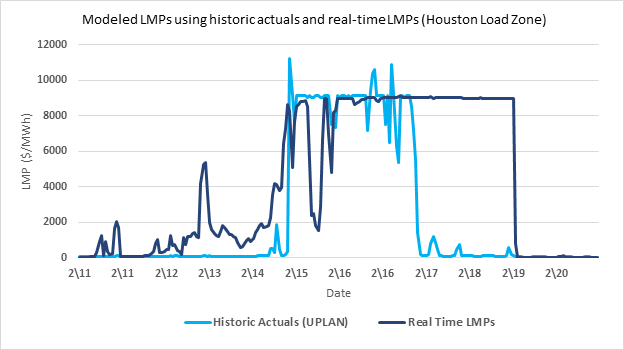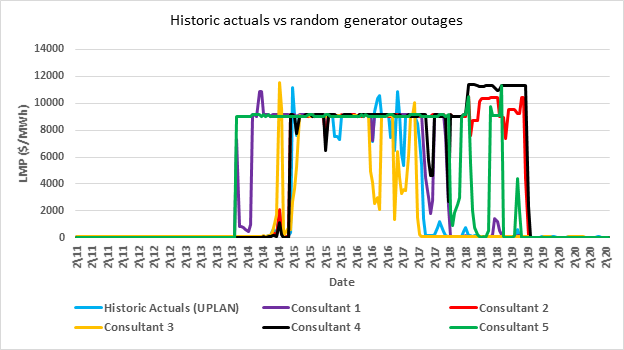|
News
|
LCG, October 10, 2023 – LCG Consulting (LCG) has released its annual outlook of the ERCOT wholesale electricity market for 2024, based on the most likely weather, market, transmission, and generator conditions.
Read more
|
|
LCG, October 10, 2023 – LCG Consulting (LCG) has released its annual outlook of the ERCOT wholesale electricity market for 2024, based on the most likely weather, market, transmission, and generator conditions.
Read more
|
|
|
Industry News
Study: Extreme Event Generator Outages in Texas
LCG May 6, 2021--February’s extreme weather left millions of Texans without power after pushing an unprecedented 45 GW of generation off the system. At least 111 people died, some as a direct result of heating and power failure. The disaster captured the nation’s attention and led the Texas legislature to pursue changes to electricity pricing and how the ERCOT Board members are chosen, as well as to create new emergency rules and oversight.
Now that more data from the emergency is available, LCG Consulting has conducted a simulation study to examine the behavior and consequences of extreme event generator outages on the prices of electricity. Are the 2021 prices specific to the series of outages that occurred, or would a similar disaster take place under other outage conditions? We were also curious if we could replicate similar prices in UPLAN when we generate outage events on a much more catastrophic scale that we normally model.
Five consultants at LCG each developed an approach to building a simulation that captures the electricity prices, in the form of LMPs (locational marginal prices). This parallel modeling helps deconstruct and mitigate the impact of generator outages during any extreme events. All the consultants used UPLAN to generate LMPs from their scenarios.
In this study, stochastic methods are used to simulate random outages for the duration of extreme weather conditions. Each consultant independently developed their approach, although all used common underlying fundamentals. They looked at February 11 through February 20, 2021. The consultants mostly used family of exponential distribution, though one employed a normal distribution skewed to the right, indicating most of the outages occurred on the earlier days of the event.
Failure or exponential distributions are often used to describe the intervals of occurrences of random events. With our study it can be used to simulate how often an outage can happen. Another technique used to replicate the clustered outages that happened during the first few days of the winter storm week was to draw a random hour from the first few days to artificially trigger an outage early in the simulation period. Other considerations defined at the outset include the expected total capacity and fuel type or mix of generators on outage (e.g., natural gas, coal, nuclear, renewables), and whether the same unit can go through only one or more outages during the simulation.
Random outages were created on the generators across the ERCOT region to trigger the scarcity price spikes. Figure 1 and Figure 2, below show the LMPs for Houston Load Zone. Figure 1 compares the Real Time LMPs against the UPLAN Simulation that was created using the actual historic generator outage data. Carrie Bivens, a vice president of Potomac Economics, the market monitor of ERCOT, commented that the high prices continued after the generator outage ended because of pricing intervention. The discrepancy between the UPLAN simulated results and the reported market prices for the last 40 hours was due to intervention.

Figure 1: Houston LZ LMPs Comparison using Actual Data in UPLAN vs Real Time LMPs
Figure 2 compares the Houston LZ LMPs between the UPLAN simulations using historic market data against the LMPs simulated in multiple studies, with randomly created generator outages.

Figure 2: Houston Load Zone LMPs using randomly created generator outages
From Figures 1 and 2 it is observed that each random outage event creates a different price profile, showing how difficult it would be to predict the price of a volatile commodity like electricity during extreme events. According to ERCOT protocol, the electricity prices during system-wide outages are set by Operating Reserve Demand Curve (ORDC). Our consultants’ scenarios had observed system-wide shortages varying from 325 GWh to almost 3,000 GWh. Although UPLAN can capture high prices during extreme conditions, more information is needed to replicate the precise pattern of high prices to gauge the overall impact. Nonetheless, UPLAN plus stochastic methods do produce results that reasonably match those that occurred.
The LMPs are set at the shadow price of $9000/MWh whenever there is system-wide outage; however, they can exceed that at certain times due to the congestion in the system. These are true for the price curves from Consultant 2 and Consultant 4, as the random outages had a very significant, albeit different in detail, on how the power flowed and created congestion in the system.
To add to this problem, injecting more renewables in the grid makes supply forecasts even more uncertain adding to the volatility, and this in turn puts reliability of grid into spotlight.
For more reading about grid security see The Grid Security Question.
|
|
|
|
UPLAN-NPM
The Locational Marginal Price Model (LMP) Network Power Model
|
|
|
UPLAN-ACE
Day Ahead and Real Time Market Simulation
|
|
|
UPLAN-G
The Gas Procurement and Competitive Analysis System
|
|
|
PLATO
Database of Plants, Loads, Assets, Transmission...
|
|
|
|
|
